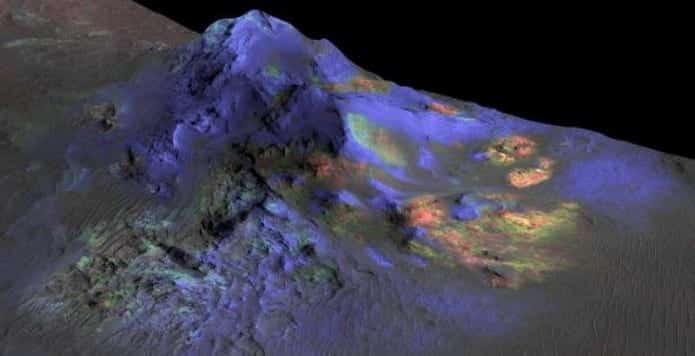Glass deposits on Martian surface may provide an insight into ancient signs of life on the planet
A team of researchers from Brown University, used data from NASA’s Mars Reconnaissance Orbiter (MRO) and were able to detect glass deposits within impact craters on Mars which are assumed to have formed in the scorching heat of a violent impact. These glass depositions might just provide an insight into ancient signs of life on the Red planet.
Earlier astronomical studies have shown that it is possible to preserve ancient bio-signatures in an impact glass.
Kevin Cannon, a PhD student at Brown University said: “Knowing this, we wanted to go look for them on Mars and that is what we did here. Before this paper, no one had been able to definitively detect them on the Martian surface”.
Cannon and a co-author Jack Mustard, who is professor of Earth, environmental and planetary sciences at the Brown University together showed that there are considerably large glass deposits present in several well preserved ancient craters that are scattered across the Martian surface.
The study basically pointed out that these glass deposits are relatively common impact features on Mars and they can be used for further exploration
Generally, scientists need to measure the spectra of light that gets reflected off the planet’s surface for remote identification of different mineral and rock types.
However, the impact glass is a bit different as it does not have any particular strong spectral signal.
Jack Mustard said: “Glasses tend to be spectrally bland or weakly expressive, so signatures from the glass tend to be overwhelmed by the chunks of rock mixed in with it. But Kevin found a way to tease that signal out.”
Cannon, carried out an experiment in the laboratory by mixing the powders of Martian rocks which had similar composition and then fired them in an oven in such a way so as to form glass. He then measured the spectral signal using this glass.
Next, Cannon recorded the spectral signal that he got from the lab glass and then by using algorithmic designs he was able to pick out the similar signals from the satellite’s data i.e. from MRO.
With this technique the duo were able to detect even smaller amounts of deposits around several crater central peaks.
Finding deposits on central peaks is an indication that they have an impact origin and it is already a known fact that the impact glass can preserve ancient signs of life. This knowledge can open new fields in the Mars expedition and going forward glass deposits can be the targets for future exploration.
The duo researchers said: “We think these could be interesting targets for future exploration. In fact, we have a particular spot in mind.”
Hargraves, is one of the craters that has been found to contain glass and it located near the Nili Fossae trough that is a long depression which stretches across the Martian surface.
As of now the Nili Fossae trough is believed to date from a time when Mars was a much wetter place and hence it has lots of scientific significance.
Says Mustard: “If you had an impact that dug in and sampled that subsurface environment, it’s possible that some of it might be preserved in a glassy component. That makes this a pretty compelling place to go look around, and possibly return a sample.”
Readers can get complete details of this research which has been published online in the journal Geology.

